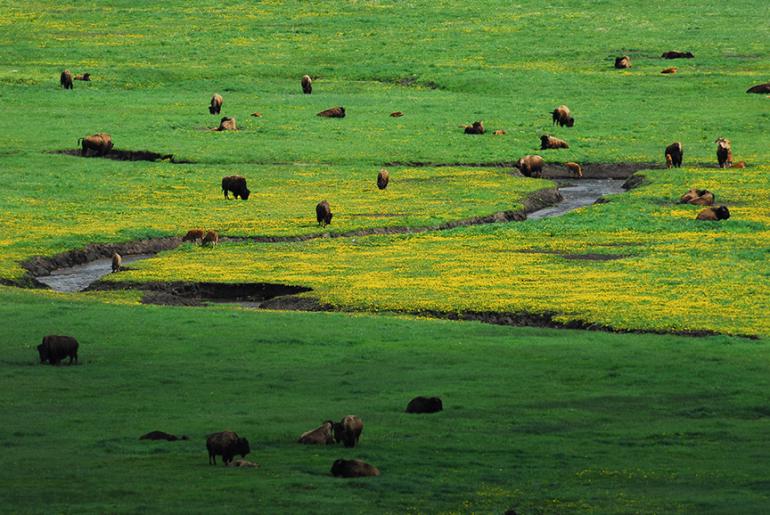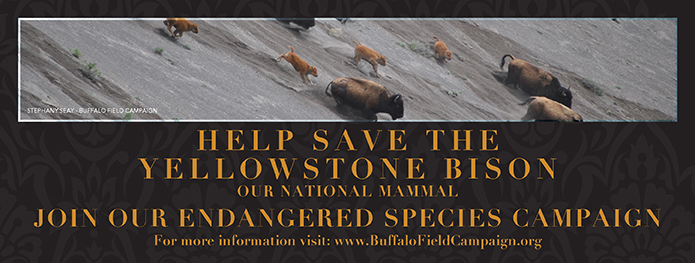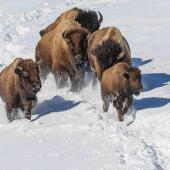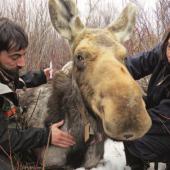Yellowstone Buffalo Battles
Yellowstone’s wild, free-roaming buffalo are a unique wildlife resource. Certainly we can fashion a Montana solution that shares the land with our buffalo and their annual movements without slaughtering them every time they step into Montana. Buffalo provided food, clothing, and shelter for Native Americans. They fed the explorer and railroad builder. Without the buffalo, the West would have been a land of starvation. It is only right that we make a permanent place for them in Montana, managed as wildlife.
In the early 1800's there were 60 million buffalo on the prairies and in the mountains of North America. In the late 1800's they were commercially slaughtered by the thousands for their tongues, hump meat, skins, and dried bone. The U.S. Army encouraged the buffalo slaughter in order to subdue the Plains Indians. Cattle grazers, sod busters, and land speculators then occupied the Plains.
By 1890, fewer than 1,000 buffalo remained in North America. By 1902 only 23 were counted in the Pelican Valley, just east of Yellowstone Lake. In 1905, 21 buffalo were reintroduced into the park to improve genetics, and eventually all were moved into the Lamar Valley. In 1936, buffalo from the Lamar herd were moved into the Hayden Valley and Firehole country. By 1954, there were 1,477 wild, free-roaming buffalo within the park wintering in three distinct herds.
In 1966, Yellowstone Park managers adopted a policy of "natural management" that meant no more killing within park boundaries. Through the years, however, Montana sold hunting licenses for buffalo that migrated across park boundaries. The hunting achieved a certain amount of population control, and the restless buffalo were allowed to roam into Montana with little notice of their coming and going.
Montana hunters then successfully pressured the 1985 state legislature to pass a state law "reaffirming buffalo as a legitimate game animal." This reemphasized the rights of public licensed hunters to harvest surplus buffalo outside park boundaries. Fundraising public hunts followed, with hunters harvesting, removing, and utilizing all of the carcasses with no waste of meat, trophy heads, or hides.
Population Growth
In 1988, the buffalo population numbered 3,500. During the winter of 1988-89, snow and cold temperatures forced the buffalo to lower elevations, resulting in the widest migration in over 100 years. Livestock grazers in the upper Yellowstone Valley complained about the migrating buffalo knocking over fences, eating their grass, and threatening to spread brucellosis disease to their cattle.
The Montana Department of Fish, Wildlife & Parks (FWP) opened a planned special hunt, which took place along highways and roads outside the boundaries of Yellowstone Park. The “hunt” was highly visible to anti-hunting activists with camcorders. Capitulating to the demands of cattlemen, FWP used no discretion in managing the hunt and when the shooting was over, 569 buffalo were killed. News coverage of the fate of the great beasts caused a national uproar. People across the country could not understand why the buffalo were not allowed to migrate to winter forage areas. Hunters took all of the blame.
Montana Law
Subsequently the 1991 state legislature eliminated legal buffalo hunting in Montana, although the law still recognized buffalo as wildlife. Then in 1995, the legislature passed a bill transferring management authority of buffalo to the Department of Livestock (DOL). Thus began a series of winter slaughters by the DOL culminating in the shooting of over 1,000 buffalo in the winter of 1997. The prevention of the spread of brucellosis from buffalo to cattle was the reason given.
Brucellosis in Buffalo
Yellowstone buffalo have lived with brucellosis for over 80 years since they were first infected by domestic cattle. There is no scientific evidence that buffalo re-infect cattle or any reason for the drastic and costly capture, testing, and slaughter of buffalo to reduce the risk of transmission to cattle. Most of the buffalo tested do not have the disease or have developed immunity.
On January 1, 1999 the Agriculture Plant Health Inspection Service (APHIS) requested a re-examination to soften its action against buffalo that leave Yellowstone Park in search of food. The Montana Board of Livestock rebuffed the re-examination. APHIS defines low-risk brucellosis buffalo as bulls, calves, non-pregnant cows, and cows that have completely passed a placenta. These buffalo should be allowed to winter forage until 60 days before the permitted cattle return on June 15. APHIS said such tolerance would not endanger Montana's brucellosis-free status.
DOL's definition of low-risk is a buffalo that is not pregnant and has tested negative for exposure to brucellosis. This virtually means all buffalo are considered high risk and are shot, slaughtered, or hazed back to the park.
Brucellosis is a seasonal contagious disease. The window of infection is from March 15 to June 1. Reproductive-age domestic cows are most susceptible to the disease. Replacing them with brucellosis-proof cattle and introducing a brucella vaccination are practical methods to continue grazing livestock on buffalo ranges.
Current Status
Recently Governor Schweitzer requested that FWP and DOL not participate in the hazing and capture of buffalo. But since January 5th, 2006 APHIS, Yellowstone National Park Service crews, and US Homeland Security agents have been moving the captured buffalo from Yellowstone to slaughter plants in Montana and Idaho, a distance of over 500 miles. More than $181,300 has been spent on this program. APHIS has spent $4,300,000 on buffalo since 2002 including funds for research, testing, personnel, and equipment. Since the 1930s the US Department of Agriculture has spent three billion dollars trying to eradicate brucellosis.
The buffalo quarantine facilities Phases I, II, and III place legitimacy on hazing, capturing, testing, quarantining, and slaughtering under the guise of research. Federal agencies hope that after four-plus years of quarantine, a buffalo will emerge, free of brucellosis, at a cost of $13,100 per animal. Phases I and II quarantine and fencing will block buffalo and elk movement to winter ranges on the east side of the Yellowstone River below Gardiner. Habitat purchased for wildlife winter range in Bear Creek, Eagle Creek, Phelps Creek, Little Trail Creek, Bassett Creek, Cedar Creek, Slip & Slide Creek, Dome Mountain, and Daily Lake are waiting for buffalo. Quarantining diverts attention from enlarging buffalo habitat and refining migration corridors to winter habitat.
Managing Yellowstone buffalo as wildlife, instead of diseased livestock, will open up many recreation opportunities that would be an economic plus for Montana—and it will save the land for our buffalo and their comings and goings. For the Gardiner and West Yellowstone areas it is a step in the right direction. As wildlife biologist Jim Posewitz says, "Montana still has the opportunity to do it right. After that is accomplished let the other states feel free to follow."
Joe Gutkoski is Vice President and co-founder of the American Buffalo Foundation.
Get more involved
For more information about Brucellosis or to get involved with Yellowstone bison management, check out these resources.
Buffalo Field Campaign
buffalofieldcampaign.org
Centers For Disease Control and Prevention
cdc.gov/ncidod/dbmd/diseaseinfo/brucellosis_g.htm
bt.cdc.gov/agent/brucellosis/
Montana Department of Fish, Wildlife & Parks, Region 3
fwp.mt.gov/hunting/brucellosis.html
Montana Department of Livestock
mt.gov/liv/animalhealth/diseases/brucellosis/bison/bison_intro.asp
National Park Service Office of Public Affairs
(202) 482-6843
Ralph Maughan’s Wildlife Reports
forwolves.org/ralph/
U.S. Agriculture Plant Health Inspection Service (APHIS)
aphis.usda.gov/vs/nahps/brucellosis/
aphis.usda.gov/vs/nahps/brucellosis/cattle.htm
(202) 720-2511 (office of public affairs)
U.S. Department of Homeland Security
dhs.gov/index.shtm
bioterrorism.slu.edu/bt/quick/brucellae01.PDF
Yellowstone National Park
nps.gov/yell/naturescience/bison.htm
Buffalo Courses Available for Spring and Summer
Yellowstone Forever
307-344-2293; yellowstoneassociation.org/institute/
These courses are taught by field biologists and experts focusing on specific Park subjects. A sampling of their buffalo field courses include "From Bison to Bighorn: The Hooved Mammals of Yellowstone" where you’ll learn first-hand about the role of bison in the Yellowstone ecosystem; and "The Bison of Yellowstone" where you'll explore the bison’s natural history, its role in native culture, and more. Check the website to enroll.
Yellowstone National Park
307-344-7381; nps.gov/yell (click on "Ranger-Led Programs")
Park rangers lead outdoor courses lasting from 20 minutes to several hours. These programs cover wildlife, geology, history, culture, and more. Many of the programs are free, but others have a modest fee. Check the website for an updated schedule and location.
Yellowstone Safari
586-1155; yellowstonesafari.com
Yellowstone Safari specializes in personalized wildlife-educational experiences that are led by biologists. The services are customized to your interest and timing, and they schedule field courses daily and year round by request. Many of these courses are based in the field, and others utilize customized vehicles or boats equipped for wildlife observation.
Yellowstone Glacier Adventure, Inc.
585-9041; national-park-tours.com
Off-road is the buzzword here. These biologist-led field courses run year round and are one day to one week long. They go off-road as much as possible, tracking and observing bison and wolf/bear interactions. They specialize in family and school programs, teaching through field observation and study—you’ll even get to put a bison skeleton back together!
Off the Beaten Path
800-445-2995 or 586-1311; offthebeatenpath.com
Travel in style with Off the Beaten Path’s five-day all-inclusive Yellowstone adventures. Local wildlife biologists and naturalists will guide your ed-ventures, timed to coincide with the best wildlife viewing. Their guided Yellowstone journey is a five-star experience, what a way to see buffalo—or for them to see you! Check the website or call and ask for "Wolves, Bears, and Wild Things: Wildlife Watching in Yellowstone National Park."
Safari Yellowstone
800-SAFARIS; safariyellowstone.com
These half, single, or multiday excursions are led by experienced naturalist/biologist guides. With Safari Yellowstone you can either dabble or immerse yourself in Yellowstone’s wildlife, ecological, and historical glory. Safari options range from a focus on photography, wildlife, adventure, hiking, family friendly, and senior.
—Kim Thielman-Ibes














